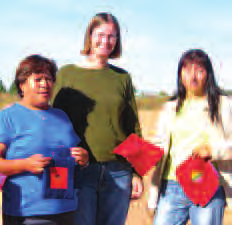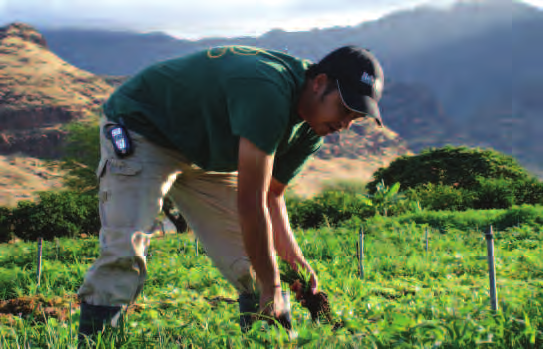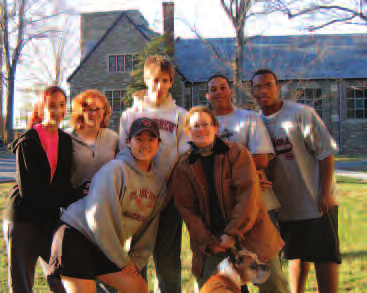education, and community rejuvenation.
like no book can teach. The camp’s garden began as a simple ten-by-twenty-foot plot, Mikey Azzara exudes an all-embracing, Italian-American enthusiasm and quasi-then grew to fifteen-by-fifty. Today, the garden covers one fifth of an acre.
romantic love for fresh food, combined with a strong New Jersey accent and the fast-Mikey and his old middle-school principal started talking about how to bring paced style of East Coast urbanites. Whether in his job coordinating outreach for the hands-on food, biology, and nutrition education into the school’s curriculum and New Jersey office of the Northeast Organic Farming Association (NOFA), or as the cafeteria. Shortly thereafter, Mikey was meeting with high school administrators as well.
founder of local farmers’ markets and school gardens, Mikey focuses on community They applied for a grant to have an all-organic day in the cafeteria and for Mikey to networking and tackling big tasks from as many angles as possible. Mr. Mikey, as flocks teach organic cooking to the junior class. Mikeyś Italian heritage, and the fact that his of local elementary school students call their twenty-seven year old gardening brother is a professional chef, adds authenticity and zest to his lessons.
instructor, launches himself like a flushed free-range turkey into organizing local, state, Instead of confronting administrators and cafeterias to demand more organic and regional initiatives. He aspires to transform the very way that families eat.
food, Mikey strives to cultivate demand from the students. He started a food club at the 154 : o u t s t a n d i n g y o u t h
u n c o m m o n w i s d o m : 155


high school, and helped them install raised-bed gardens, an apple tree, and picnic tables on school grounds. Mikey asked teachers to make announcements to classes about the Standing Up for Change
new club, and he was soon chaperoning students on farm visits, teaching them how to make ice cream, and screening films like Fast Food Nation. Students now run the club, which aims to get more local, farm-raised food into the cafeteria.
Last year, Mikey organized an open house for educators and administrators to learn about what was brewing in Lawrenceville. The superintendent of the district pressed Mikey,“How can we make this happen at all the schools in the district?”
Shortly after he began the public school outreach efforts,
new mexico :
Mikey learned that NOFA New Jersey was searching for an
outreach coordinator. He was torn between applying for a job
colonias development council
that would enable him to make regional impacts and the thought
of abandoning his budding efforts in Lawrenceville public
Las Cruces is a friendly, if fast-growing, 70,000-person town at the schools. When NOFA agreed to help Mikey continue the programs
southern border of New Mexico, cradled between the mountains and the while tackling regional coordination, he knew he had found the
mesas. If perhaps it lacks the romantic air of Taos or the turquoise tint of right job. Mikey organizes NOFAś large winter conference and
Santa Fe, it does boast psychedelic sunsets smeared across an infinite sky their summer education conference, each drawing hundreds of
and a terrific burrito bar, the family-run Chihuahua’s, where the flour farmers and organizers from all over the state.
tortillas are doughy and light to the point of being ethereal. Most of its Recognizing the importance of bringing together
unassuming citizens (university-affiliated, army, or retirees) would never potential allies, Mikey organized a farmer-chef conference with
guess that only a few miles south—and east, and also north—teem over seven chefs and seven farmers. Together, they made lists of
thirty colonias, rural subdivisions inhabited by landowners, up to 18,000 in products one demanded and the other supplied, and began
one community, who might lack potable water, wastewater systems, directly sourcing local food to local eateries. The next conference passable roads, or safe housing.
ballooned to 150 chefs and farmers. Soon the Lawrenceville
The Colonias Development Council (CDC) has known this for a
Culinary Partnership was born and the first “Taste of
while. The group has gone through as many names as it has self-conscious Lawrenceville” festival took off in October of 2006.
incarnations: beginning as the Farmworker Organizing Project (operating With programs, projects, and plans sprouting from all
by means of the Catholic Social Ministries), morphing into the Colonias sides, Mikey attended the global Slow Food conference in Italy, in Organizing Project (a more radical social activist group), and finally, twenty 2006, to share his story, and learn about organic food efforts
years later, identifying as the CDC, a now solid, methodical group, most of whose worldwide. He was also one of four young farming advocates
nineteen members are younger than thirty.
chosen to play a part in the 2006 Farm Aid concert. Prior to the If the CDC has transformed over the years, the problems they attack remain concert, he participated in farm tours and sat on a panel with
much the same. Mexican farmworkers—some documented, some not—have been music legends Willy Nelson, Neil Young, and Dave Matthews.
living on small colonia lots, in some cases for decades. Eighty percent of them fully or Before representatives from the national media, he talked about
partially own the land on which they live, as compared with the 64 percent state his efforts and explained their importance.
average. But the parcels of land they purchase from developers, who subdivide a While feverishly organizing and networking to promote
sixteen-acre square into increasingly tiny bits, often lack basic amenities, easy access, local food have afforded Mikey his share of time in the spotlight, and septic tanks.
nothing could strip him of his roots. Mr. Mikey’s thick accent
The real estate contract fees are exorbitant and predatory, since residents often clearly shows that, despite widespread praise, an exceptional
lack a bank account or credit history and make too little money to apply for loans. Those education, and international experience, he will always remain a who miss even one payment are at risk of having their property seized, nullifying years hometown boy from Lawrenceville.
156 : o u t s t a n d i n g y o u t h
u n c o m m o n w i s d o m : 157
of disbursement. The developers, for their part, claim that predatory practices, like a 15
morning and offering organic food courses. After the recent flooding, FEMA reclaimed percent interest rate, simply “minimize risk.”
the land for emergency housing, and the county granted their request. Twenty-two Rhetoric has it that the border patrol and the sheriff don’t work together, but local families worked to fight the ruling, however, and the garden—so far—has been collusion is frequent; often, entire communities are locked down and searched with left untouched.
dogs.“At CDC, we’ve totally reconceptualized citizenship and are unconcerned about Megan has been working with a group of women to erect a child care center.
whether the homeowners are legal residents,” says Megan Sneddan, who has been with Currently, the Columbus Center, a double-wide trailer, has twenty-four children and work CDC for seven years. Megan points out that many, having been granted amnesty in the for five part-time employees, but use of the facility fluctuates with peaks and troughs in 1980s or been landowners for ages, are legal.“Talk of illegality makes people suspicious, the picking season. It could accommodate more children, but the seven-dollar-per-child keeps them from coming to meetings, and in effect creates an anti-community,” she daily fee exceeds what many can afford.“It’s tough to manage, and far from sustainable,”
says. We believe that if you’re civically engaged, in other words engaged economically, Megan says.“Most of the women stopped their education after second grade, so small-politically, and socially, then you’re providing a service to your society, whether or not business skills are lacking, but how do you solve that?”
you have the paper.”
A long-planned day care center in Chaparral has expanded to include a The cultivation of southern New Mexico’s four main agricultural products—
commercial kitchen, sewing room, and multi-purpose room, but the original idea to pecans, onions, chili, and cotton—has become increasingly mechanized, sloughing away build it from straw bales proved too expensive and the group has resigned itself to available human jobs. Many citizens of the colonias have no experience performing tasks purchasing a quadruple-wide trailer instead.“Instead of something environmentally like opening a bank account, figuring out their taxes, or buying land. Often, families of efficient that benefits local construction, we’ll have to get a pre-fab building from out-four must make do on a yearly income of $12,000. Unlike many of the 1400 colonias in of-state,” says Megan ruefully.“Long-term, it’s the worse investment, but it’s all we have Organizing can have lots of different
the state of Texas, New Mexican colonias usually have access to water, and increasingly to the money for. If we try to raise more funding, we’ll lose the money that’s already been faces, argues Ray.“It doesn’t matter
wastewater systems. Their biggest problem, instead, is substandard housing. Dodgy granted, so we’re kind of stuck.” She sighs,“I wanted it as much as they did.” Megan’s at whether you schedule one-on-one
wiring often sparks trailer fires, and trailers built pre-1976 are ineligible for insurance.
once disappointing and stimulating anecdote underscores the complexity of the meetings or big parades,” he says.“Is it
Currently, CDC works with nine of the thirty-seven colonias in three organizers’ work.
challenging power relations in its own
neighboring counties. Mauricio de Segovia works with youth in two of them, preaching Ray Padilla, now a teacher at a local charter high school, managed a CDC youth way? If it does that, it’s organizing.”
the gospel of critical thinking.“I want them to be civically engaged,” he says.“I want center project in the 1990s that imploded after student artists graffitied a Zapata quote them to question.” As they complete their bachelor’s degrees in accounting, Elva Varela they considered inspirational on a mural. Some locals interpreted it as incendiary and and Erika Contreras teach finance on the colonias, both one-on-one and at night classes ordered it removed. Although Legal Aid lawyers rubbed their hands gleefully at the for parents at the elementary school. Lessons include how to file taxes, read a credit prospect of an easy court victory, too few of the parents were willing to represent their report, and choose a bank, for instance.
children in the case. Many of them worked at the school cafeteria or as teacher’s aides, Patrick Wenger, a former intern, has taken on the issue of affordable housing by and they had too much to lose.
investing in a machine that produces cheap-but-sturdy compressed earth blocks from
“It was a lesson in power relations,” says Ray. CDC now approaches its work dirt, water, and a bit of cement. The idea is to build earth-block duplexes and more moderately, less “in-your-face,” as Megan calls it.“We have to balance economic greenhouses where people can grow vegetables to sell at the future farmers’ market in sustainability while at the same time keeping on with the organizing,” she says.“So we Anthony—linking affordable, energy-efficient housing with economic development and do more diverse kinds of work. We lose members when we stray from the basics.”
food security.“This area is all agribusiness, so the only thing most people grow on their Organizing can have lots of different faces, argues Ray.“It doesn’t matter own are maybe green chilies,” Patrick says.“They buy everything else at Wal-Mart or whether you schedule one-on-one meetings or big parades,” he says.“Is it challenging Sam’s Club, depending on where the sales are.” Building the earth-block homes would power relations in its own way? If it does that, it’s organizing. Had we been more use local materials, local labor, and because adobe stabilizes temperature much more moderate about the youth center, it might still be here. These people didn’t come here efficiently than thin trailer walls, energy costs would plummet.
to become radical socialists, remember. They came for the American dream.”
A waste services conglomerate proposed building a landfill atop the colonia in Megan believes CDC can help people change their lives little by little. There are Chaparral. With the help of CDC, community leaders took the case all the way to the over fifty-thousand people living in New Mexican colonias, but the dogged nineteen—
Supreme Court. Members of another colonia, this one hundreds of years old, had spent in the squat white building that houses CDC—have decided, at least for now, that the two years planting a community garden, involving local children every Saturday best way to make improvements is slowly, steadfastly, a few people at a time.
158 : o u t s t a n d i n g y o u t h
u n c o m m o n w i s d o m : 159

Farm Grows Native Leader
play a larger role in planning for the farm’s expansion. Farming the land has changed his life and his thinking.“By working on the farm and growing crops,” he says,” I think I can help slow development in the area. The more land I farm, the fewer houses will be built, the less infrastructure. We already have a four-lane highway and six fast food restaurants down the street,” he says.“We don’t need more.”Manny is making better food choices for himself, too, choosing fresh food over fast food and being conscious of where his food comes from.
Among his lessons growing up, Manny’s parents taught
hawaii : manny miles
him about the value of hard work and encouraged his appreciation for community.“My Dad would grow corn for us and for the
neighbors,” he says.“We learned to take care of the land.” Manny’s Amidst the majestic mountains lined with picturesque kukui nut trees and lush mother is also one of his strongest supporters. He reflects,“She flora, Lualualei valley provides a unique setting for an organic farm, Mala ‘Ai ‘Opio. The loves gardening and being outdoors, and she encouraged me to
farm, more commonly known as MA‘O Organic Farms, not only provides food to the local stick with it.”
community, but also affords opportunities for young people.
As a Native Hawaiian, Manny has also gained a deeper
Manny Miles is one such example. He gained work and leadership skills as part of appreciation for his own culture and the ‘aina,’ or land. “I’m more in MA’O’s Youth Leadership Training Program. A typical teenager, he graduated from high tune with the culture,” he says.“I take care of the land because later school and planned to attend Bethel College to play soccer. But mixed feelings on what to it will take care of me.”
do with the rest of his life, and the thought of traveling so far from home, put his college The Waianae Community Re-Development Corporation
plans on hold.
founded MA’O in 2001 as a community food service initiative. MA‘O
Farming was not on Manny’s “top ten” list of career choices, but when the Farm’s mission is to develop a comprehensive local food system, to opportunity for an internship arose, he decided to give it a try. Manny went through the fight hunger, improve nutrition, strengthen local food security, and program and has worked his way up from student intern to apprentice to farm manager.
empower low-income families to move toward self-sufficiency. By
He began on the farm when he was eighteen and is now twenty-four years old.
implementing the student agricultural program, they hope to
“I never thought I’d be a farmer, but always liked working outdoors,” he says.
enhance the lives of local youth.
His first experiences on the farm left much to be desired, and he admits he “didn’t The student agricultural program is geared towards
have the love for it yet.” A typical sixty-five to seventy hour work week left him individuals between seventeen and twenty-five years of age. It offers drained and exhausted.
training in both leadership and organic farming.Youth are paid part-Manny now takes college classes and works what he considers part-time, forty time wages for working on the farm—a rare opportunity for young
hour per week. The garden crops he manages range from bananas, taro, lemons, and people in the Waianae community, where unemployment often
mangoes to choi sum, mesclun greens, radishes, and spinach. The goal for MA’O is to have runs three times the state average.They are also paid to complete a wide variety of items available for sale at the local farmers’ markets.
an academic program and receive certification at the local
Although he is pursuing a degree in business, Manny has no intention of community college. Recruitment begins at the local high schools
abandoning his crops. He prefers being in the field to sitting behind a desk, and hopes with kids who really are excited about farming.
to strike a balance where he can spend 70 percent of his time outdoors and 30 percent
“About 90 percent of the kids in this community are remedial in math and in an office.
“By working on the farm and growing crops,
English,” Manny says.“The farm-to-college program helps them advance their skills.” And a
“Working everyday on the farm is easier than going to school. At school, I’m both I think I can help slow development in the
lot of the kids that come into the program need motivation and inspiration in order to mentally drained and physically drained,” he says.
area. . . . We already have a four-lane
avoid adverse lifestyles, he adds.
The serene surroundings of MA’O Organic Farms mask the overdevelopment of highway and six fast food restaurants down
At first, Manny felt like the only kid his age engaged in this type of work, but after the area. Just down the street, in what was recently a rural area, are a McDonald’s, the street; we don’t need more.”
attending national and international farming conferences, he has a different perspective:“I Kentucky Fried Chicken, and 7-Eleven. The farm just purchased eleven acres to add to their don’t feel alone in this business anymore. I now have a sense of place and know where I original five acre plot, and Manny hopes that by obtaining his degree, he will be able to need to go.”
160 : o u t s t a n d i n g y o u t h
u n c o m m o n w i s d o m : 161


Shaping Tomorrow's Leaders
afternoon, fifteen to twenty students work outside with Joy—planting, irrigating, and weeding. They produce compost from campus leaf waste, horse manure, and all the nonanimal leftovers. Students harvest salad greens, beets, herbs, squash, tomatoes, peppers, and sweet potatoes for meals in the dining hall, and ultimately return their food scraps to the soil.
“What’s critical is that these students in the
“The kids who work in the garden make an announcement at meal times about future, whether they’re politicians or
what food on the menu came from the garden,“Joy says.“They always get a huge round lawyers or bankers or doctors, (because
of applause from the other kids!”
they’re probably not all going to be
delaware : joy mcgrath
Before Joy instituted composting in the dining hall, each 360-person meal farmers), understand that their food is
produced fourteen to fifteen gallons of food waste.“Now we’re down to about two grown somewhere.”
gallons, just because of the composting,” she says.
During the 1950s and 1960s,
The garden is seeping into the school curriculum in
pedestrian traffic around the Wilmington,
amazing and unexpected ways. English classes have come out
Delaware, farmers’ market was so robust
to help because “if you want to understand a poem Seamus
that police were called in for crowd
Heaney wrote about digging potatoes, it’s hard to do unless
control. With Delaware’s thriving
you’ve actually dug potatoes,” Joy says. The Chinese class
agricultural community, the farmers’
worked on the garden while doing Buddhist work meditations
market in Wilmington brought tens of
and the girls JV soccer team shovels compost as an alternative
thousands of people to the city to buy
to practice.
fresh products.
“We’re looking at the campus as a whole system,”
“They’d actually have to blow
explains Joy.“That is the bedrock of organic and sustainable
whistles and stop the people so the cars
production. We’re looking for new methods of tillage, new kinds
could get through,” says Joy McGrath,
of fertilizer, and new buffers for our ponds. We’re taking the two thirty-two.
acre organic garden as a model and trying to figure out how to
Joy grew up just fifteen minutes
continue that practice.”
from Middleton, Delaware, where her
Joy also sits on St. Andrew’s sustainability committee,
grandfather had a fruit and vegetable farm
working to support local food systems. So far the school has
that joined Wilmington’s market twice a
succeeded in getting all of its pork products, honey, and a lot of week. Her father operated the farm as a
fruits and vegetables from within a hundred-mile radius. In the
greenhouse and nursery business.
future, Joy would like to raise free-range chickens at St. Andrew’s Today the landscape looks
that could supply eggs and fertilizer, and be used for pest
starkly different than it did when Joy was
management.
growing up. St. Andrew’s boarding high school in Middletown, where Joy is in charge of
“What’s critical is that these students in the future,
public relations and fundraising, is being strangled from all sides by suburbanization.
whether they’re politicians or lawyers or bankers or doctors,
Middletown has annexed more than 4000 acres since 1998, and the population has (because they’re probably not all going to be farmers),
grown from 3800 in 1990 to 11,500 in 2007. In the midst of this development, Joy leads understand that their food is grown somewhere,” Joy says.“That
efforts to preserve the school’s 1500 acres of prime farmland and more than 600 acres might seem laughable to a lot of people, especially farmers, but I of forest and wetlands.
don’t think most kids coming to St. Andrew’s, as smart as they
The McGrath family lost their farm to new highway construction, and Joy’s are, actually understand the practices and economics driving
father is now director of farmland preservation for the state of Delaware. With his help, what food they’re eating. To be leaders in the U.S. in twenty
Joy transformed two acres on St. Andrew’s campus into a thriving organic garden. Each years, they’ll have to understand that.”
162 : o u t s t a n d i n g y o u t h
u n c o m m o n w i s d o m : 163

Babes in the Backcountry
The Babes’ mission goes beyond wilderness technique to embody a holistic experience. Leslie believes that through teaching young women skills for the backcountry, they develop more self-respect and a greater regard for the environment.
She explains,“When people get a real sense of respect for themselves through outdoor training and leadership skills, that’s what helps save the countryside, that’s what helps us restore the earth.”
At 9:30 a.m., the participants meet the staff, break up into skill levels, and head to the hill.The morning is spent on skiing drills with personal feedback.The group reunites for colorado : leslie ross
lunch, and then returns to the slopes for the afternoon.The day ends with an Après-Ski party, which includes a table from High Country Conservation Alliance with information on sustainable practices and ways to get involved in the community.
At 5:30 a.m. in the morning, in
Colorado’s New Belgium Brewing Co., one of the organization’s sponsors, brings a below freezing temperatures, three
lot of life to the Après-Ski with materials about their sustainability practices, and of course, young women are schlepping incredible
plenty of drinks.The Après gathering gives women time to relax and enjoy each other’s bundles of ski equipment into the “Astro
company, while reminiscing on the adventures of the day and planning their next outing. In Sister,” as the Babes in the Backcountry
the evening, the instructors return the gear to storage, knowing that thirty new Babes have call their fourteen-passenger cargo van.
acquired “the adventure bug.”
Founded in 1997 by Leslie Ross,
The idea for Babes came to Leslie after finishing college. She was already an Babes in the Backcountry creates a
The Babes’ mission goes beyond wilderness
avid skier, but wanted to expand her backcountry skills. She began making backcountry unique learning environment for women
technique to embody a holistic experience.
skiing trips to the Colorado’s Summit Huts Association’s wilderness cabins. Looking back, to learn technical backcountry skills.The
Leslie believes that through teaching young
she recalls that it wasn’t until she was spending all of her time at the huts that she program aims to provide women with
women skills for the backcountry, they
noticed she was often the only female amongst the groups there. Leslie realized that the confidence to explore the
develop more self-respect and a greater
there was a serious lack of female mentors, so when she began skiing competitively in backcountry on their own.
regard for the environment.
the free skiing circuit, she was inspired by meeting other strong and accomplished Leslie, a three-time National
women skiers. At competitions she met mentors and made friends, who now also Telemark Free Skiing Champion, created
instruct her courses. In a society in which media tells young women that they must look Babes so women could find female
a certain way, Babes honors all t









